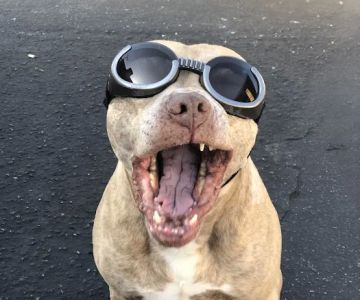Tips for Training an Aggressive Dog: Effective Strategies for Pet Owners
Having a dog with aggressive tendencies can be challenging, and I know firsthand how overwhelming it can feel when your furry friend displays aggressive behavior. However, aggression in dogs doesn’t have to be a permanent issue. With patience, consistency, and the right techniques, you can help your dog become more calm, balanced, and well-mannered. Over the years, I’ve learned that understanding the root causes of aggression and employing positive reinforcement strategies are essential to successfully training an aggressive dog. In this article, I’ll share some of the best tips I’ve used to transform my dog’s behavior, and I hope they will help you too.
1. Understanding the Causes of Aggression in Dogs
Before we dive into the training tips, it’s essential to understand why your dog is aggressive in the first place. As I’ve learned through experience, aggressive behavior in dogs is often rooted in fear, territorial instincts, or a lack of socialization. Sometimes, a dog may become aggressive due to past trauma or negative experiences. Understanding these triggers will help you address the issue more effectively. I’ve found that when you address the underlying cause of the aggression, you’re more likely to see real progress in your dog’s behavior.

1225 Warren Ave, Downers Grove, IL 60515, USA
See Details1.1 Fear-Based Aggression
Fear-based aggression is one of the most common causes I’ve seen in dogs. When a dog feels scared or threatened, they may react aggressively as a defense mechanism. For example, I once had a rescue dog who was extremely fearful of new people and would bark and lunge at strangers. In these cases, the aggression stems from the dog’s desire to protect themselves from what they perceive as a threat.
1.2 Territorial Aggression
Some dogs are naturally territorial and may become aggressive when they feel their space is being invaded. This was a challenge I faced with my own dog when she started growling at visitors or barking excessively at other dogs passing by our yard. Territorial aggression is often more common in dogs who feel a strong need to protect their home or owner.
1.3 Lack of Socialization
Lack of socialization can also lead to aggression. When dogs are not exposed to different people, animals, and environments early on, they can become fearful and reactive. Socialization is a crucial part of a dog’s development, and I’ve seen firsthand how dogs who weren’t properly socialized can struggle with aggression toward other dogs or even people.
2. Tips for Training an Aggressive Dog
Now that we understand the causes of aggression, let’s talk about practical training tips. I’ve learned that patience and consistency are key. Training an aggressive dog requires time and dedication, but with the right approach, you can significantly reduce aggressive behavior. Here are the training strategies I’ve used that have worked wonders:
2.1 Positive Reinforcement
Positive reinforcement is one of the most effective training techniques I’ve found for dealing with aggressive behavior. This involves rewarding your dog for calm, non-aggressive behavior rather than punishing them for acting out. I’ve learned that dogs respond better to rewards like treats, praise, or playtime when they exhibit desirable behavior. For example, when my dog started to calm down around strangers, I would give her a treat to reinforce the calm behavior. Over time, she learned that staying calm and non-aggressive brought positive results.
2.2 Socialization and Exposure
Socialization is critical for any dog, but especially for those exhibiting aggressive behavior. I made sure to expose my dog to various environments, people, and other dogs at a pace she was comfortable with. Gradually introducing her to new situations helped her build confidence and reduced her fear of the unknown. If you have an aggressive dog, I recommend starting with controlled environments, such as walking your dog at a distance from other dogs, and slowly decreasing that distance as your dog becomes more comfortable.
2.3 Consistent Command Training
Consistency is essential in dog training, and it’s something I learned quickly when dealing with aggression. I made sure to reinforce basic commands like “sit,” “stay,” and “come” consistently. Teaching your dog to respond to commands not only improves their overall behavior but also gives you control in situations where aggression might arise. Whenever my dog showed signs of aggression, I would use a command she was familiar with to redirect her attention and keep her focused on me.
2.4 Addressing Fearful Aggression
If your dog’s aggression is fear-based, as mine was with my rescue dog, it’s essential to help them build trust and confidence. I began by exposing her to new people slowly and rewarding her with treats for calm behavior. Over time, I noticed that her fear diminished as she realized she had nothing to be afraid of. Another strategy I found helpful was desensitization, which involves gradually exposing your dog to the things that scare them in a controlled, safe manner.
2.5 Seeking Professional Help
Sometimes, despite our best efforts, we need the help of a professional. I reached out to a certified dog trainer when I encountered particularly tough behavioral issues with my dog. A professional can offer personalized training plans and guidance, which was extremely helpful when dealing with complex aggressive behavior. If your dog’s aggression persists, don’t hesitate to contact a professional who specializes in aggressive dog behavior.
3. Building a Strong Bond with Your Dog
Throughout my journey of training an aggressive dog, I learned that building a strong bond with your dog is just as important as any training technique. When my dog felt safe and secure with me, her behavior began to improve. I spent time playing, walking, and bonding with her daily, which strengthened our relationship and helped her trust me more. A solid bond not only makes training easier but also ensures that your dog looks to you for guidance and reassurance in stressful situations.
3.1 Spending Quality Time Together
Spending quality time with your dog is essential to overcoming aggressive behavior. I made sure to incorporate regular play sessions, walks, and training into our routine. This helped my dog learn to associate me with positive experiences, making her more likely to listen and trust me in situations where aggression could arise.
3.2 Positive Interaction
Positive interactions, like petting, praise, and playing with your dog, can go a long way in building a strong connection. Whenever my dog showed non-aggressive behavior, I praised her and gave her attention. This not only reinforced positive behavior but also helped her understand that good behavior results in rewards.
4. Preventing Aggressive Behavior in the Future
Preventing future aggression is crucial in maintaining a peaceful home for both you and your dog. After working through the initial aggression issues with my dog, I focused on maintaining consistent training and positive reinforcement. I also continued to expose her to new environments, people, and experiences to ensure she remained well-adjusted. Regular training sessions kept her behavior in check, and I’ve noticed that the more I worked with her, the more she started to feel at ease in different situations.
4.1 Maintaining Consistency
Consistency is key to preventing aggressive behavior in the long run. I made sure to continue the training even after my dog’s behavior had improved. Regularly reinforcing commands and rewarding good behavior helped her stay on track and feel confident in her environment.
4.2 Ongoing Socialization
Even after addressing the initial aggression, I kept up with socialization and exposure. I continued introducing my dog to new situations and people, ensuring she remained comfortable and well-adjusted in different environments. This ongoing exposure helped her stay calm in unfamiliar settings and prevented future aggression from developing.
Training an aggressive dog is undoubtedly challenging, but it’s also incredibly rewarding. With patience, consistency, and the right strategies, I’ve seen firsthand how aggressive behavior can be transformed. If you’re dealing with an aggressive dog, I encourage you to try these tips and, if needed, seek professional help. Together, you and your dog can build a strong, positive relationship and create a more peaceful and enjoyable home environment.










